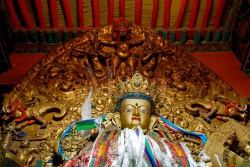Bhavanga Sota
The first term may tentatively be rendered as the 'undercurrent forming the condition of being, or existence', and the second as 'subconsciousness', though, as will be evident from the following, it differs in several respects from the usage of that term in Western psychology.
Bhavanga (bhava-anga), which, in the canonical works, is mentioned twice or thrice in the Patthāna, is explained in the Abhidhamma commentaries as the foundation or condition (kārana) of existence (bhava), as the sine qua non of life, having the nature of a process, lit. a flux or stream (sota). Herein, since time immemorial, all impressions and experiences are, as it were, stored up, or better said, are functioning, but concealed as such to - full consciousness, from where however they occasionally emerge as subconscious phenomena and approach the threshold of full consciousness, or crossing it become fully conscious. This so-called 'subconscious life-stream' or undercurrent of life is that by which might be explained the faculty of memory, paranormal psychic phenomena, mental and physical growth, karma and rebirth. etc. An alternative rendering is 'life-continuum'.
It should be noted that bhavanga-citta is a karma-resultant state of consciousness (vipāka, q.v.), and that, in birth as a human or in higher forms of existence, it is always the result of good, or wholesome karma (kusala-kamma-vipāka), though in varying degrees of strength (s. patisandhi, end of the article). The same holds true for rebirth consciousness (patisandhi) and death consciousness (cuti), which are only particular manifestations of subconsciousness. In Vis.M. XIV it is said:
"As soon as rebirth-consciousness (in the embryo at the time of conception) has ceased, there arises a similar subconsciousness with exactly the same object, following immediately upon rebirth-consciousness and being the result of this or that karma (volitional action done in a former birth and remembered there at the moment before death). And again a further similar state of subconsciousness arises. Now, as long as no other consciousness arises to interrupt the continuity of the life-stream, so long the life-stream, like the flow of a river, rises in the same way again and again, even during dreamless sleep and at other times. In this way one has to understand the continuous arising of those states of consciousness in the life-stream." Cf. viññāna-kicca.
